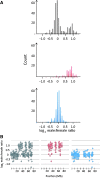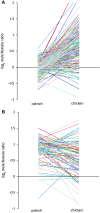Lack of dosage compensation accompanies the arrested stage of sex chromosome evolution in ostriches
- PMID: 23329687
- PMCID: PMC3603317
- DOI: 10.1093/molbev/mst009
Lack of dosage compensation accompanies the arrested stage of sex chromosome evolution in ostriches
Abstract
Sex chromosome evolution is usually seen as a process that, once initiated, will inevitably progress toward an advanced stage of degeneration of the nonrecombining chromosome. However, despite evidence that avian sex chromosome evolution was initiated >100 Ma, ratite birds have been trapped in an arrested stage of sex chromosome divergence. We performed RNA sequencing of several tissues from male and female ostriches and assembled the transcriptome de novo. A total of 315 Z-linked genes fell into two categories: those that have equal expression level in the two sexes (for which Z-W recombination still occurs) and those that have a 2-fold excess of male expression (for which Z-W recombination has ceased). We suggest that failure to evolve dosage compensation has constrained sex chromosome divergence in this basal avian lineage. Our results indicate that dosage compensation is a prerequisite for, not only a consequence of, sex chromosome evolution.
Figures


References
-
- Brawand D, Soumillon M, Necsulea A, et al. (18 co-authors) The evolution of gene expression levels in mammalian organs. Nature. 2011;478:343–348. - PubMed
-
- Ellegren H, Smeds L, Burri R, et al. (12 co-authors) The genomic landscape of species divergence in Ficedula flycatchers. Nature. 2012;491:756–760. - PubMed
Publication types
MeSH terms
Substances
LinkOut - more resources
Full Text Sources
Other Literature Sources

